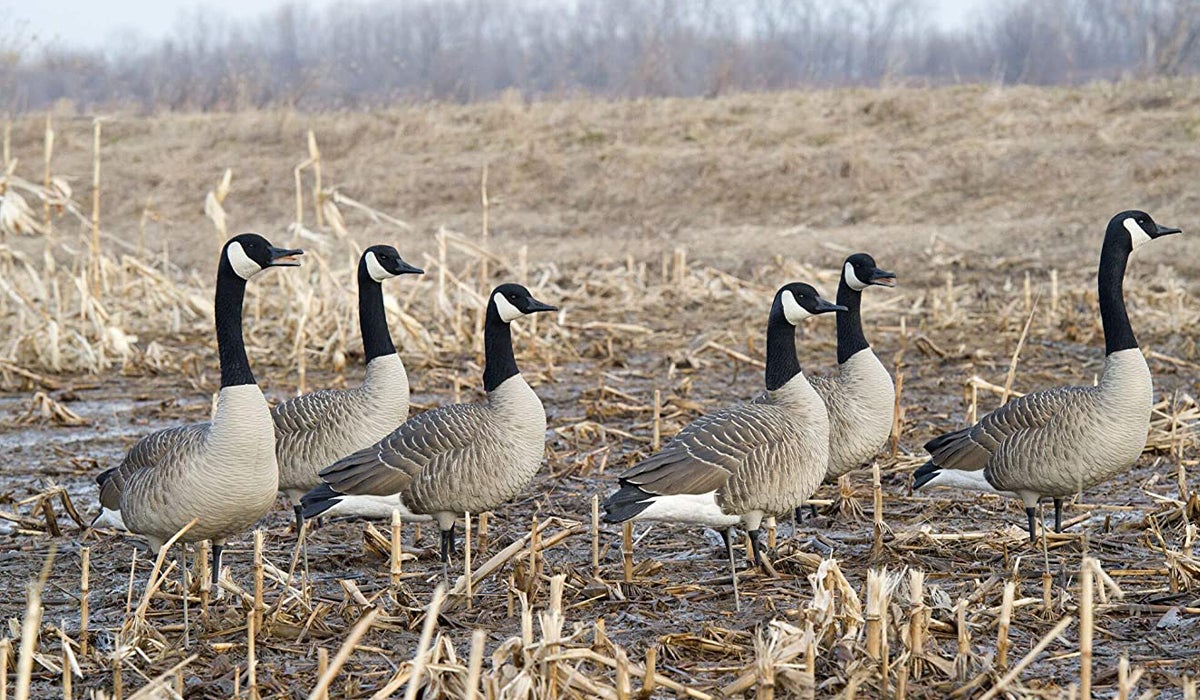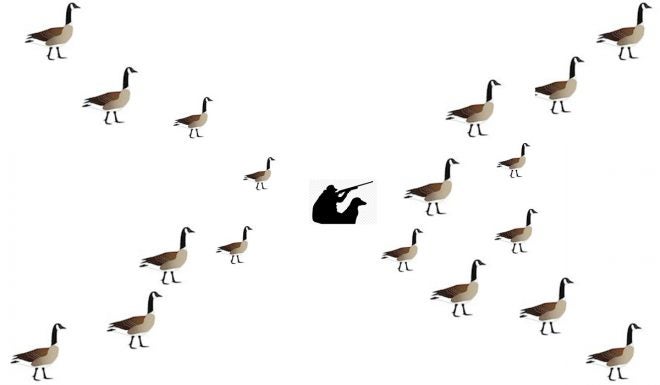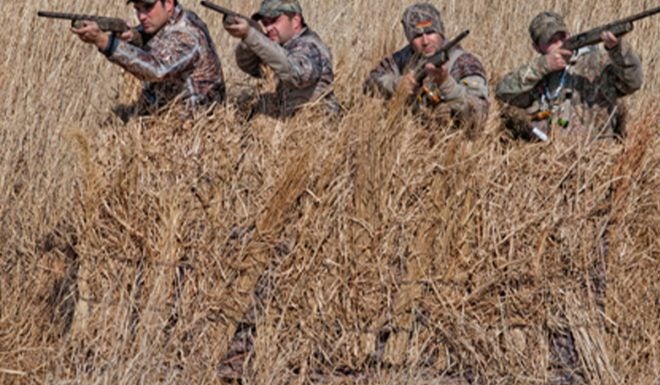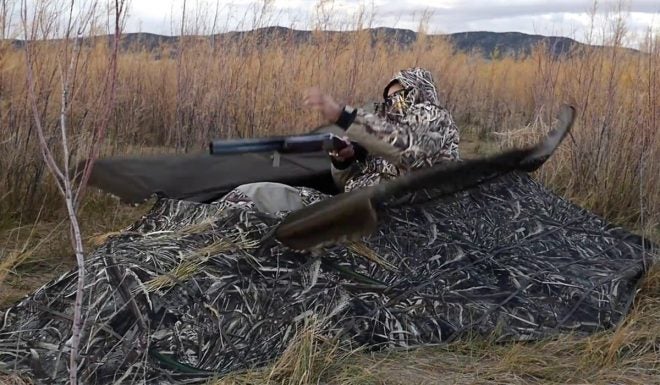Five Goose Hunting Decoy Spreads that Actually Work
Derrek Sigler 09.17.20

My wife always laughs when goose season is upon us. She says I can’t hear her ask me from the other end of the couch, to load the dishwasher, but I can hear a lone honk from the other end of the county. My mostly-clean truck is now cluttered with binoculars, call lanyards, a plat book for each county around us and an off-road GPS navigation system. The bed is full with a small decoy spread, waders and a couple layout blinds, too. Let’s just say, I take it seriously. Everyone likes to chime in with decoy spreads that work everywhere, and there are some that are generally considered to be the classic spread. However, not every decoy spread works for every occasion and field. Here are five spreads that I’ve used over the past 25+ years of hunting across North America that have actually worked.
X marks the spot

We’ll start off with the classic “X.” You often hear about hunters wanting to be on the X and there is good reason. You’ve done the work and scouted the field the geese want to be in and even have a pretty solid plan for where in the field they are going to drop in. If you were to look at your spread from above, the decoys form an “X” shape in the field, with you being positioned pretty much in the center, or to the bottom of the “X.” I did some hunting in Saskatchewan where we hunted out of blinds in the center of the X. We could then shoot from all directions depending on what open space of the X that the birds wanted to land in. That is the big thing with a decoy spread.

Geese, like many other birds, seek safety in numbers. Where they see other birds feeding, they will be attracted to. A decoy spread is designed to give you void spaces within the decoys that the incoming birds will be drawn toward, and you’re there waiting to shoot them when they fly in. An X spread gives you four voids. A lot of hunters will sit with the four voids in front of them, but if you have the right situation and blind design, you can center yourself, spread the decoys out further into each direction and create a bigger overall footprint in the field with which to attract birds to. If you have a portable pit-style freestanding blind, you can pull this one off easily. The centered X spread is a great way to hunt multiple BIG flocks.
Pro Tip: Always mud your blinds and brush them in as much as possible. It can be all the difference.
The Big Dipper
I named this spread after the constellation because it looks a lot like the Big Dipper from above. We started out with this spread through trial and error on a field that always produces geese, but man, was it hard to hunt for a while. It’s a long, rectangular field with multiple crops, several trees and a nasty swamp changing up the landscape. The spot that always seems to pull in birds is close to a fence line and a stump. The stump provided a spot where we could pivot a decoy spread around for the wind while still having good cover for blinds.

The Dipper spread gives you several voids, with your “honey hole” being right in the center. The hole in the center has proven to be a great way to draw in singles and doubles as the day wears on. Because of that, you need your best looking decoys around that void. I like to run Avian X decoys, and have a mix of feeders, relaxed uprights and some lessers around the center of the Dipper void. One trick I’ve picked up during the grind, is to move an entire spread around as the hunt winds down, so that if I’m running an X or another spread, I’ll switch it to something closer to the Dipper after we’ve seen the main flights. That center void is really enticing to single and doubles, especially younger birds. We’ve capped off a lot of limits this way.
Pro Tip: Make sure your decoys are visible and try to get some movement in them. Tie a string to one and yank on it if you have to to get it to move.
The String

I was hunting with one of my oldest and dearest friends, and we were out scouting geese. We came up on a field where I had permission to hunt and we watched the geese land in a way that gave me an idea for this spread. It was windy, and the first flock landed in kind of a line, and then the flocks that followed all seemed to dump to one side of the line. The land itself was the key, and is something that I have hunted other places as well.

The field was very hilly, and the birds seemed to follow the flock in, like a landing strip. We set up decoys with a long line going out and then a big cup on one end, with the wind hard to our back. The birds came in hard and we limited out quickly. As we were picking up, my buddy laughed that the birds came in on a string, and the name stuck. The key here is to be as brushed in as possible at the base of the void. I have a couple of large, oversized layout blinds that I have mudded and brushed so much I had grass growing on one during the off season. One things I did find out was that some of the blinds designed for bigger hunters actually have a lower profile, which is advantageous to this setup. Look at the Final Approach Pro-Guide XL or the Alps OutdoorZ Zero Gravity blinds.
Pro Tip: Coat your new blind with a thick mud and let it dry. Then knock the mud off. This cuts the UV glare and gives you a good base for brushing it in.
The U

The U spread is shaped like a big horseshoe and works good for smaller spaces or where you have to set yourself up against something, like a tree or fence line. It’s quite effective in early seasons, when the flocks are smaller and naive. We had great luck going out and setting an arc of decoys with the wind and plunking down under a tree out in the field.

If it’s legal in your area, a crane decoy at one of the ends is an amazing confidence decoy. Anyone who has ever seen cranes and geese in the same field knows that geese are drawn to be in the same vicinity as a wary crane. Have yourself positioned to be facing the void and you can have a great hunt.
Pro Tip: Crane decoys work amazing with duck hunting, too.
The Y

The Y spread had me asking why I hadn’t done it sooner when we started using it years ago. I was hunting fields right off a big golf resort ( I know, major score!). The main field had a chunk of hardwoods in the middle that pushed the birds to one side or the other when they cupped and committed. We tried all kinds of spreads, and most would work to some degree, but the one day we were trying to get situated when it was clear that birds were in the air and we had to hustle. All we had set was a smaller V shape at the end and a longer line extending down. We had to set off to the side, and we hammered the geese. And I mean HAMMERED them. The spread looks like a Y with us, off to the side, almost like a Y. ( and we were the period). This has become my go-to spread for big flocks later in the season. I think it somewhat resembles what a migrating flock looks like as they drop in where some other birds already were down and eating.
I have several calls I use, but with this setup, only two ever seem to get used. I have a Zinks Long Neck Rocker that is killer on big flocks and when I’m in the open. I also have a Sure Shot Honker that has a great raspy tone that works great as a finishing call, or when I’m around that same field with the clump of trees. The honk bounces off the woods and gets a great echo.
Pro Tip: Switch up your calls and the angle you’re calling from as they birds fly. This makes your flock sound bigger.
Pro Tip: The big takeaway from all of these types of decoy spreads is, don’t be too stuck in a rut. Be flexible and be ready to change things up, especially on the fly. Scouting is vital and try to set your spread to look like the birds do naturally. Happy Honker Hunting!
